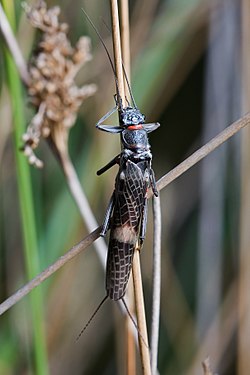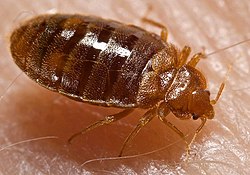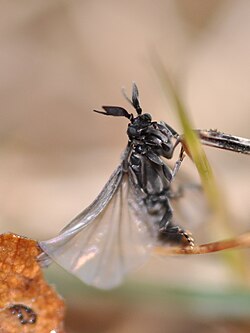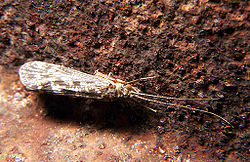List of insect orders

Insecta is a class of invertebrates that consists of around 30 individual orders.[1] Orders are the fifth taxonomic rank used to classify living organisms, below the rank of class, but above the rank of family.[2] The exact number of insect species is uncertain, however it is estimated to be between 1.5 million and 7 million.[3] More than 1 million insects have been formally described by a taxonomist and assigned a binomial name.[4] Insects are the most diverse group of animals, and account for 80% of species on Earth.[5] The most diverse orders are: Coleoptera (beetles), Hymenoptera (wasps, bees and ants), Lepidotera (butterflies), Diptera (flies) and Hemiptera (cicadas).[6] Taxonomists disagree on the exact number of orders, with opinions ranging from 26 to 32 distinct extant orders.[7]
Insecta was divided into seven orders in 1758 by Carl Linnaeus in the 10th edition of Systema Naturae. Orders were primarily defined by the number and structure of wings, with other factors such as antennae being considered.[8] The classification of insects changes, with species regularly shifted around.[9] The most recent order described was the monotypic Mantophasmatodea.[9]
Apterygota
[edit]Apterygota is a former subclass of insects, and one of the original subclasses Carl Linnaeus assigned to insecta. (the other being Pterygota).[10] They are wingless, with small appendages on segments of their abdomen.[10]
| Order | Description | Number of species | Image |
|---|---|---|---|
| Archaeognatha | The Archaeognatha are the most evolutionarily primitive taxa in insects.[11] Species are characterized by their elongated bodies and retractable mouthparts. They have an arched thorax and a small head.[11] Bodies are cylindrical, and do not have any scales.[12] They are distributed globally, and prefer woodland areas.[12] Their tails consist of three long structures, and can use them to jump up to 12 inches.[13] | Approximately 500.[14] | 
|
| Zygentoma | Species of Zygentoma are usually flat with two lengthy cerca.[15] The most widely distributed species is the Silverfish (Lepisma saccharinum).[16] The thoraxes are wide, and the surface is covered in small, dry scales.[17] Most live under bark or litter structures.[17] They are most common in humid environments, but some species have developed to withstand higher temperatures.[17] | Approximately 400.[18] | 
|
Palaeoptera
[edit]Palaeoptera is an infraclass of insecta with 2 existing orders.[19] Wings of Palaeoptera cannot be folded back when they are not being used, and species undergo particularly significant changes during metamorphosis.[20]
| Order | Description | Number of species | Image |
|---|---|---|---|
| Ephemeroptera | Ephemeroptera (commonly known as "Mayflies") are small aquatic insects found primarily in North America.[21] Females lay their eggs in water, and do not feed during the adult stage. They spend almost their entire lives as larvae (sometimes up to a year), before growing into adults and living for 1 or 2 days.[21] | Approximately 2,000.[22] | 
|
| Odonata | Odonata consists primarily of dragonflies and damselflies. They are large, narrow insects characterised by clear wings and a long abdomen.[23] Species are brightly colored and up to 2 inches in length. They are aquatic and lay their eggs in or around bodies of water.[23] | Approximately 6,400.[24] | 
|
Polyneoptera
[edit]Polyneoptera is a group of winged insects that possess mouths specialized for chewing, long antennae and 4 wings.[25][a] When stationary, their wings are typically folded over their body flat.[26] The exact relationship between orders is disputed among taxonomists, and some authorities classify Phasmatodea and Orthoptera in a single group called Orthopterida.[27]
| Order | Description | Number of species | Image |
|---|---|---|---|
| Blattodea | Blattodea is an order that contains cockroaches and termites.[28] They have oval bodies and short cerci. They are most common in tropical climates, and can live as pests in human structures.[29] | Approximately 4,600.[29] | 
|
| Dermaptera | Dermaptera (commonly known as "Earwigs" are insects that undergo incomplete development, in that they skip a larvae stage in their life cycle.[30] Thy are slender with beaded antennae, a segmented body and pincer-like cerci.[30] | Approximately 1,800.[31] | 
|
| Grylloblattodea | Grylloblattodea (also known as "ice crawlers") are a rare group of insects found in Asia and North America.[32] Their bodies are adapted to survive in cold and mountain climates.[33] | Approximately 60.[34] | 
|
| Mantodea | Mantodea (commonly known as "mantises") are an order of insects that usually prey on other insects.[35] They exhibit a diverse range of colors and shapes, and are distributed worldwide.[35] | Approximately 2,500.[36] | 
|
| Mantophasmatodea | gladiators or heelwalkers | Approximately 15.[37] | 
|
| Orthoptera | grasshoppers, crickets, katydids | More than 20,000.[38] | 
|
| Phasmatodea | stick and leaf insects | Approximately 3,600.[39] | 
|
| Plecoptera | stoneflies | Approximately 3,500.[40] | 
|
| Zoraptera | angel insects | 44 have been described.[41] | 
|
Paraneoptera
[edit]Paraneoptera is a superorder of insects that undergo an incomplete metamorphisis.[42] Many species are agricultural pests, damaging the plants that they feed on.[43] The lifespan of species in Paraneoptera are short, with some lasting 6 weeks or less.[44]
| Order | Description | Number of species | Image |
|---|---|---|---|
| Hemiptera | Hemiptera (also known as "true bugs") are aquatic insects that do not have a pupal stage during development.[45] They have piercing mouthparts that are used to suck from their food, with species exhibiting a cone or beak shaped structure.[45] | More than 100,000.[46] | 
|
| Psocodea | Psocodea is a group of small insects with soft bodies.[47] It consists primarily of lice, and species are dorsoventrally flattened across their bodies.[47] | Approximately 11,000.[48] | 
|
| Thysanoptera | Thysanoptera (also known as "Thrips") are small winged insects that feed on plants.[49] They are usually no more than 2 millimeters in length, and are attracted to bright colors.[49] | Approximately 5,500.[50] | 
|
Holometabola
[edit]Holometabola is a group of insects that are characterized by complete metamorphosis (insects that undergo an egg, pupae, larvae and adult stage).[51] The orders Coleoptera, Hymenoptera, Diptera and Lepidoptera contain the greatest number of species in this group (more than 99%).[51]
| Order | Description | Number of species | Image |
|---|---|---|---|
| Coleoptera | beetles | Approximately 350,000.[52] | 
|
| Diptera | flies, mosquitoes, gnats | Over 125,000.[53][b] | 
|
| Hymenoptera | ants, bees, wasps | Approximately 150,000.[54] | 
|
| Lepidoptera | butterflies and moths | Approximately 180,000.[55] | 
|
| Mecoptera | scorpionflies | Approximately 500.[56] | 
|
| Megaloptera | dobsonflies and alderflies | Approximately 330.[57] | 
|
| Neuroptera | lacewings, antlions | More than 5,000.[58] | 
|
| Raphidioptera | snakeflies | Approximately 260.[59] | 
|
| Siphonaptera | fleas | Approximately 2,500.[60] | 
|
| Strepsiptera | twisted-wing parasites | Approximately 600.[61] | 
|
| Trichoptera | caddisflies | Around 200.[62] | 
|
Notes
[edit]References
[edit]- ^ "Guide to Insect and Non-Insect Arthropods" (PDF). AgriLIFE Extension - Texas A&M System. 2018. Retrieved 2025-06-15.
- ^ Rawat 2023, p. 14
- ^ Stork, Nigel E. (2018-01-07). "How Many Species of Insects and Other Terrestrial Arthropods Are There on Earth?". Annual Review of Entomology. 63 (63): 31–45. doi:10.1146/annurev-ento-020117-043348. ISSN 0066-4170. PMID 28938083. Archived from the original on 2025-06-15. Retrieved 2025-06-15.
- ^ "The Insect Effect: Insect Decline and the Future of Our Planet". Thompson Earth Systems Institute. Retrieved 2025-06-16.
- ^ "Numbers of Insects (Species and Individuals)". Smithsonian Institution. Archived from the original on 2017-09-22. Retrieved 2025-06-15.
- ^ "Insect taxonomy". Science Learning Hub. 2019-11-11. Archived from the original on 2025-06-15. Retrieved 2025-06-15.
- ^ Rivers 2017, p. 179
- ^ Engel, Michael S.; Kristensen, Niels P. (2013-01-07). "A History of Entomological Classification". Annual Review of Entomology. 58 (58): 585–607. doi:10.1146/annurev-ento-120811-153536. ISSN 0066-4170. PMID 23317047. Archived from the original on 2024-10-13. Retrieved 2025-06-16.
- ^ a b Ring & Resh 2003, p. 565
- ^ a b White & Borror 1970, p. 56
- ^ a b "Jumping Bristletails". Encyclopedia of Arkansas. 2022-09-01. Retrieved 2025-06-16.
- ^ a b "Order Archeognatha – ENT 425 – General Entomology". NC State Agricultural and Life Sciences. Retrieved 2025-06-16.
- ^ "[Occasional Invaders] A New Look at an Old Group". Pest Control Technology. 2011-05-27. Retrieved 2025-06-16.
- ^ "Bristletails (Archaeognatha) • FlyFish Circle". FlyFish Circle. Archived from the original on 2023-09-28. Retrieved 2025-06-15.
- ^ "Order Zygentoma – ENT 425 – General Entomology". NC State Agriculture and Life Sciences. Retrieved 2025-06-16.
- ^ Molero-Baltanás, Rafael; Mitchell, Andrew; Gaju-Ricart, Miquel; Robla, Jairo (2024-05-01). "Worldwide revision of synanthropic silverfish (Insecta: Zygentoma: Lepismatidae) combining morphological and molecular data". Journal of Insect Science (Online). 24 (3): 1. doi:10.1093/jisesa/ieae045. ISSN 1536-2442. PMC 11069193. PMID 38703100.
- ^ a b c "Børstehaler". Artsdatabanken (in Norwegian Bokmål). 2014-03-22. Archived from the original on 2020-03-29. Retrieved 2025-06-16.
- ^ "Zygentoma". Royal Entomological Society. Archived from the original on 2025-03-21. Retrieved 2025-06-15.
- ^ "Paleoptera - (General Biology I) - Vocab, Definition, Explanations | Fiveable". library.fiveable.me. Retrieved 2025-06-16.
- ^ Gillott, Cedric (1980), Gillott, Cedric (ed.), "Paleoptera", Entomology, Boston, MA: Springer US, pp. 121–136, doi:10.1007/978-1-4615-6915-2_6, ISBN 978-1-4615-6915-2, retrieved 2025-06-16
- ^ a b "Mayflies | National Wildlife Federation". National Wildlife Federation. Archived from the original on 2025-04-27. Retrieved 2025-06-16.
- ^ "Ephemeroptera". ucmp.berkeley.edu. Archived from the original on 2025-05-28. Retrieved 2025-06-15.
- ^ a b "Odonata | Dragonflies & Damselflies, Aquatic Insects | Britannica". www.britannica.com. Archived from the original on 2025-03-18. Retrieved 2025-06-16.
- ^ Waller, John T.; Willink, Beatriz; Tschol, Maximilian; Svensson, Erik I. (2019-12-12). "The odonate phenotypic database, a new open data resource for comparative studies of an old insect order". Scientific Data. 6 (1): 316. Bibcode:2019NatSD...6..316W. doi:10.1038/s41597-019-0318-9. ISSN 2052-4463. PMC 6908694. PMID 31831730.
- ^ a b "Orthopteroids – ENT 425 – General Entomology". NC State Agricultural and Life Sciences. Retrieved 2025-06-16.
- ^ Taylor, Christopher (December 1, 2014). "Polyneoptera". Archived from the original on 2025-05-13. Retrieved 2025-06-16.
- ^ Gullan & Cranston 2010, p. 207
- ^ "ITIS - Report: Blattodea". www.itis.gov. Archived from the original on 2022-02-21. Retrieved 2025-06-16.
- ^ a b "Order Blattodea – ENT 425 – General Entomology". Archived from the original on 2023-11-28. Retrieved 2025-06-16.
- ^ a b "Order Dermaptera – ENT 425 – General Entomology". NC State Agriculture and Life Sciences. Archived from the original on 2025-02-13. Retrieved 2025-06-16.
- ^ "Dermaptera - earwigs | Wildlife Journal Junior". www.nhptv.org. Archived from the original on 2024-06-25. Retrieved 2025-06-15.
- ^ Jarvis, Karl J.; Whiting, Michael F. (2006). "Phylogeny and biogeography of ice crawlers (Insecta: Grylloblattodea) based on six molecular loci: designating conservation status for Grylloblattodea species". Molecular Phylogenetics and Evolution. 41 (1): 222–237. Bibcode:2006MolPE..41..222J. doi:10.1016/j.ympev.2006.04.013. ISSN 1055-7903. PMID 16798019.
- ^ Schoville, Sean D.; Roderick, George K. (2010-06-02). "Evolutionary diversification of cryophilic Grylloblattaspecies (Grylloblattodea: Grylloblattidae) in alpine habitats of California". BMC Evolutionary Biology. 10 (1): 163. Bibcode:2010BMCEE..10..163S. doi:10.1186/1471-2148-10-163. ISSN 1471-2148. PMC 2898686. PMID 20525203.
- ^ "Order Grylloblattodea – ENT 425 – General Entomology". Archived from the original on 2025-02-13. Retrieved 2025-06-15.
- ^ a b "Marvellous Mantodea". University of Oxford. 2018-01-01. Archived from the original on 2025-06-18. Retrieved 2025-06-17.
- ^ Kolnegari, Mahmood; Fasano, Antonio; Zareie, Khalil; Panter, Connor T. (2022). "Opportunistic depredation of songbird nestlings by female praying mantids (Mantodea: Mantidae)". Ecology and Evolution. 12 (12): e9643. Bibcode:2022EcoEv..12E9643K. doi:10.1002/ece3.9643. ISSN 2045-7758. PMC 9748410. PMID 36523528.
- ^ "Gladiator bug | Insects of the Order Mantodea | Britannica". www.britannica.com. Retrieved 2025-06-15.
- ^ "Orthoptera | Description, Insect Order, Grasshopper, Cricket, Katydid, Natural History, & Classification | Britannica". www.britannica.com. 2025-04-24. Retrieved 2025-06-15.
- ^ "Order Phasmatodea – ENT 425 – General Entomology". Archived from the original on 2025-02-13. Retrieved 2025-06-15.
- ^ "Stoneflies (Plecoptera) • FlyFish Circle". FlyFish Circle. Retrieved 2025-06-15.
- ^ Kočárek, Petr; Horká, Ivona; Kundrata, Robin (2020-01-12). "Molecular Phylogeny and Infraordinal Classification of Zoraptera (Insecta)". Insects. 11 (1): 51. doi:10.3390/insects11010051. ISSN 2075-4450. PMC 7023341. PMID 31940956.
- ^ "Paraneoptera". Royal Entomological Society. Archived from the original on 2025-04-17. Retrieved 2025-06-16.
- ^ "1KITE Database -1,000 Insect Transcriptome Evolution". 1kite.cngb.org. Retrieved 2025-06-16.
- ^ Panizzi & Parra 2012, p. 106
- ^ a b "Order Hemiptera". www.macroinvertebrates.org. Retrieved 2025-06-17.
- ^ "Hemiptera". Royal Entomological Society. Retrieved 2025-06-15.
- ^ a b Poirier, Lisa. "Psocodea – Lice". Pressbooks.
- ^ "Minnesota Seasons - Minnesota Barklice, Booklice, and Parasitic Lice". www.minnesotaseasons.com. Retrieved 2025-06-15.
- ^ a b "Biology and Management of Thrips Affecting the Production Nursery and Landscape". extension.uga.edu. Archived from the original on 2025-04-15. Retrieved 2025-06-17.
- ^ A. Mound, Laurence (2002). "Thysanoptera biodiversity in the Neotropics". Revista de Biología Tropical. 50 (2): 477–484. ISSN 0034-7744. PMID 12298279. Archived from the original on 2025-06-15. Retrieved 2025-06-15.
- ^ a b "Phylogeny of Holometabolous Insect Orders". Biology Department. 2021-05-04. Retrieved 2025-06-16.
- ^ Institution, Smithsonian. "Beetles (Coleoptera)". Smithsonian Institution. Retrieved 2025-06-15.
- ^ a b "Minnesota Seasons - flies (Order Diptera)". minnesotaseasons.com. Archived from the original on 2025-04-29. Retrieved 2025-06-15.
- ^ "Hymenoptera – ENT 425 – General Entomology". Archived from the original on 2025-05-14. Retrieved 2025-06-15.
- ^ "Lepidoptera Taxome Project". www.ucl.ac.uk. Archived from the original on 2018-06-30. Retrieved 2025-06-15.
- ^ "Mecoptera - scorpionflies | Wildlife Journal Junior". www.nhptv.org. Archived from the original on 2024-06-25. Retrieved 2025-06-15.
- ^ "Megaloptera". Royal Entomological Society. Archived from the original on 2025-01-21. Retrieved 2025-06-15.
- ^ "Neuroptera - Lacewings | Wildlife Journal Junior". www.nhptv.org. Retrieved 2025-06-15.
- ^ "Raphidioptera – ENT 425 – General Entomology". Archived from the original on 2025-03-28. Retrieved 2025-06-15.
- ^ "Fleas (Siphonaptera) - Factsheet for health professionals". www.ecdc.europa.eu. 2021-11-09. Retrieved 2025-06-15.
- ^ "Strepsiptera". Royal Entomological Society. Archived from the original on 2025-02-12. Retrieved 2025-06-15.
- ^ "Caddisfly | The Wildlife Trusts". www.wildlifetrusts.org. Retrieved 2025-06-15.
Bibliography
[edit]- Rivers, David (2017), Insects : evolutionary success, unrivaled diversity, and world domination, Baltimore: Johns Hopkins University Press, ISBN 9781421421704, OCLC 948805339
- Rawat, Vineeta (2023), Animal Taxonomy, Behaviour and Chronobiology, Info Capsule, ISBN 9788196080655
- White, Richard; Borror, Donald (1970), A Field Guide to the Insects of America North of Mexico (2nd ed.), Houghton Mifflin, ASIN B000K9UHRC
- Gullan, Penny; Cranston, Peter (2010), The insects : an outline of entomology (4th ed.), Wiley-Blackwell, ISBN 9781444330366, OCLC 428436711
- Panizzi, Antônio; Parra, José (2012), Insect bioecology and nutrition for integrated pest management, CRC Press, ISBN 9781439837085, OCLC 475450703
- Ring, Carde; Resh, Vincent (April 4, 2003), Encyclopedia of Insects, Academic Press, ISBN 9780080546056

